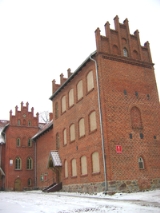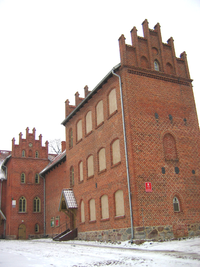
Olsztynek
Encyclopedia

Poland
Poland , officially the Republic of Poland , is a country in Central Europe bordered by Germany to the west; the Czech Republic and Slovakia to the south; Ukraine, Belarus and Lithuania to the east; and the Baltic Sea and Kaliningrad Oblast, a Russian exclave, to the north...
, in Warmian-Masurian Voivodeship
Warmian-Masurian Voivodeship
Warmian-Masurian Voivodeship, or Warmia-Masuria Province , is a voivodeship in northeastern Poland. Its capital and largest city is Olsztyn...
, in Olsztyn County
Olsztyn County
Olsztyn County is a unit of territorial administration and local government in Warmian-Masurian Voivodeship, northern Poland. It came into being on January 1, 1999, as a result of the Polish local government reforms passed in 1998. Its administrative seat is the city of Olsztyn, although the city...
. It has 7,648 inhabitants (2004).
History
The town was founded as Hohenstein by the Teutonic Order, which began to construct a castle in 1351 and granted Kulm law city rights in 1359.The Battle of Grunwald in 1410 took place in the vicinity of the town.
It became a member of the Prussian Confederation
Prussian Confederation
The Prussian Confederation was an organization formed in 1440 by a group of 53 gentry and clergy and 19 cities in Prussia to oppose the monastic state of the Teutonic Knights. It was based on the basis of an earlier similar organization, the Lizard Union...
in 1440, opposing the monastic state of the Teutonic Knights
Monastic State of the Teutonic Knights
The State of the Teutonic Order, , also Monastic State of the Teutonic Knights or Ordensstaat , was formed in 1224 during the Northern Crusades, the Teutonic Knights' conquest of the pagan West-Baltic Old Prussians in the 13th century....
but returned to its rule in 1455. With the conversion of Albert of Prussia to Lutheranism
Lutheranism
Lutheranism is a major branch of Western Christianity that identifies with the theology of Martin Luther, a German reformer. Luther's efforts to reform the theology and practice of the church launched the Protestant Reformation...
in 1525, the town became part of Protestant Ducal Prussia
Ducal Prussia
The Duchy of Prussia or Ducal Prussia was a duchy in the eastern part of Prussia from 1525–1701. It was the first Protestant duchy with a dominant German-speaking population, as well as Polish and Lithuanian minorities...
, in 1618 part of Brandenburg-Prussia
Brandenburg-Prussia
Brandenburg-Prussia is the historiographic denomination for the Early Modern realm of the Brandenburgian Hohenzollerns between 1618 and 1701. Based in the Electorate of Brandenburg, the main branch of the Hohenzollern intermarried with the branch ruling the Duchy of Prussia, and secured succession...
and after its creation part of the Kingdom of Prussia
Kingdom of Prussia
The Kingdom of Prussia was a German kingdom from 1701 to 1918. Until the defeat of Germany in World War I, it comprised almost two-thirds of the area of the German Empire...
in 1701. After the unification of Germany
Unification of Germany
The formal unification of Germany into a politically and administratively integrated nation state officially occurred on 18 January 1871 at the Versailles Palace's Hall of Mirrors in France. Princes of the German states gathered there to proclaim Wilhelm of Prussia as Emperor Wilhelm of the German...
the town lay inside the German Empire
German Empire
The German Empire refers to Germany during the "Second Reich" period from the unification of Germany and proclamation of Wilhelm I as German Emperor on 18 January 1871, to 1918, when it became a federal republic after defeat in World War I and the abdication of the Emperor, Wilhelm II.The German...
.
In the beginning of World War I
World War I
World War I , which was predominantly called the World War or the Great War from its occurrence until 1939, and the First World War or World War I thereafter, was a major war centred in Europe that began on 28 July 1914 and lasted until 11 November 1918...
in August 1914 the Russian Army
Imperial Russian Army
The Imperial Russian Army was the land armed force of the Russian Empire, active from around 1721 to the Russian Revolution of 1917. In the early 1850s, the Russian army consisted of around 938,731 regular soldiers and 245,850 irregulars . Until the time of military reform of Dmitry Milyutin in...
occupied the region but has been defeated throughout the Battle of Tannenberg
Battle of Tannenberg (1914)
The Battle of Tannenberg was an engagement between the Russian Empire and the German Empire in the first days of World War I. It was fought by the Russian First and Second Armies against the German Eighth Army between 23 August and 30 August 1914. The battle resulted in the almost complete...
.
As a condition of the Treaty of Versailles
Treaty of Versailles
The Treaty of Versailles was one of the peace treaties at the end of World War I. It ended the state of war between Germany and the Allied Powers. It was signed on 28 June 1919, exactly five years after the assassination of Archduke Franz Ferdinand. The other Central Powers on the German side of...
the League of Nations
League of Nations
The League of Nations was an intergovernmental organization founded as a result of the Paris Peace Conference that ended the First World War. It was the first permanent international organization whose principal mission was to maintain world peace...
held the East Prussian plebiscite
East Prussian plebiscite
The East Prussia plebiscite , also known as the Allenstein and Marienwerder plebiscite or Warmia, Masuria and Powiśle plebiscite , was a plebiscite for self-determination of the regions Warmia , Masuria and Powiśle, which had been in parts of East Prussia and West Prussia, in accordance with...
on July 11, 1920 to determine if the people of the southern districts of East Prussia wanted to remain within East Prussia
East Prussia
East Prussia is the main part of the region of Prussia along the southeastern Baltic Coast from the 13th century to the end of World War II in May 1945. From 1772–1829 and 1878–1945, the Province of East Prussia was part of the German state of Prussia. The capital city was Königsberg.East Prussia...
or to join the Second Polish Republic
Second Polish Republic
The Second Polish Republic, Second Commonwealth of Poland or interwar Poland refers to Poland between the two world wars; a period in Polish history in which Poland was restored as an independent state. Officially known as the Republic of Poland or the Commonwealth of Poland , the Polish state was...
. Inside the town only 2 votes were given for Poland.
In remembrance of the battles a large Tannenberg Memorial
Tannenberg Memorial
The Tannenberg Memorial commemorated fallen German soldiers of the second Battle of Tannenberg in 1914, which was named after the medieval Battle of Tannenberg...
was erected here in 1927, and made the place of the burial of the Weimar Republic
Weimar Republic
The Weimar Republic is the name given by historians to the parliamentary republic established in 1919 in Germany to replace the imperial form of government...
's President Paul von Hindenburg
Paul von Hindenburg
Paul Ludwig Hans Anton von Beneckendorff und von Hindenburg , known universally as Paul von Hindenburg was a Prussian-German field marshal, statesman, and politician, and served as the second President of Germany from 1925 to 1934....
in 1934. The memorial was partly demolished by the German forces withdrawing from the Soviet advance in 1945, after Hindenburg's coffin (and his wife's) were removed, and completely demolished by the Polish government in 1949. (A surviving lion is displayed in a Olsztynek square).
Until 1945 the town, known as Hohenstein in Ostpreußen, was part of Landkreis (district) Osterode
Ostróda
Ostróda is a town in Ostróda County in the Warmian-Masurian Voivodeship in Poland, with 33,603 inhabitants as of January 1, 2005. It lies in the Masurian Lake District and is a growing tourist site owing to its relaxing natural surroundings.-History:...
in East Prussia. In January 1945 it was occupied by the Red Army
Red Army
The Workers' and Peasants' Red Army started out as the Soviet Union's revolutionary communist combat groups during the Russian Civil War of 1918-1922. It grew into the national army of the Soviet Union. By the 1930s the Red Army was among the largest armies in history.The "Red Army" name refers to...
throughout the East Prussian Offensive
East Prussian Offensive
The East Prussian Offensive was a strategic offensive by the Red Army against the German Wehrmacht on the Eastern Front . It lasted from 13 January to 25 April 1945, though some German units did not surrender until 9 May...
. Later it was handed over to Polish authorities, the German population was expelled
Expulsion of Germans after World War II
The later stages of World War II, and the period after the end of that war, saw the forced migration of millions of German nationals and ethnic Germans from various European states and territories, mostly into the areas which would become post-war Germany and post-war Austria...
and the region was resettled with Poles especially from Polish areas annexed by the Soviet Union
Polish areas annexed by the Soviet Union
Immediately after the German invasion of Poland in 1939, which marked the beginning of World War II, the Soviet Union invaded the eastern regions of the Second Polish Republic, which Poles referred to as the "Kresy," and annexed territories totaling 201,015 km² with a population of 13,299,000...
.
In 1960 a memorial for the Battle of Grunwald
Battle of Grunwald
The Battle of Grunwald or 1st Battle of Tannenberg was fought on 15 July 1410, during the Polish–Lithuanian–Teutonic War. The alliance of the Kingdom of Poland and the Grand Duchy of Lithuania, led respectively by King Jogaila and Grand Duke Vytautas , decisively defeated the Teutonic Knights, led...
was erected.
Famous Inhabitants
- Paul Kahle (1875-1964), orientalist
- Albert LievenAlbert LievenAlbert Lieven was a German actor. He was born Albert Fritz Liévin in Hohenstein, East Prussia. He died in London, England. He was married four times, including to the actresses Susan Shaw and Valerie White....
(1906–1971), actor - Christoph Coelestin Mrongovius (1764–1855), Protestant Pastor, linguist
- Paul WendlandPaul WendlandPaul Wendland was a German classical philologist.Born in Hohenstein, Province of Prussia, he taught as a professor at the Kiel University , Breslau University , Göttingen University .He died in Göttingen.-Literary works:* Philosophische Schrift über die Vorsehung, 1892* Beiträge zur...
(1864–1915), classical philologist
Further reading
Aleksandr SolzhenitsynAleksandr Solzhenitsyn
Aleksandr Isayevich Solzhenitsyn was aRussian and Soviet novelist, dramatist, and historian. Through his often-suppressed writings, he helped to raise global awareness of the Gulag, the Soviet Union's forced labor camp system – particularly in The Gulag Archipelago and One Day in the Life of...
describes the Battle of Tannenberg (1914)
Battle of Tannenberg (1914)
The Battle of Tannenberg was an engagement between the Russian Empire and the German Empire in the first days of World War I. It was fought by the Russian First and Second Armies against the German Eighth Army between 23 August and 30 August 1914. The battle resulted in the almost complete...
in his book "August 1914".

